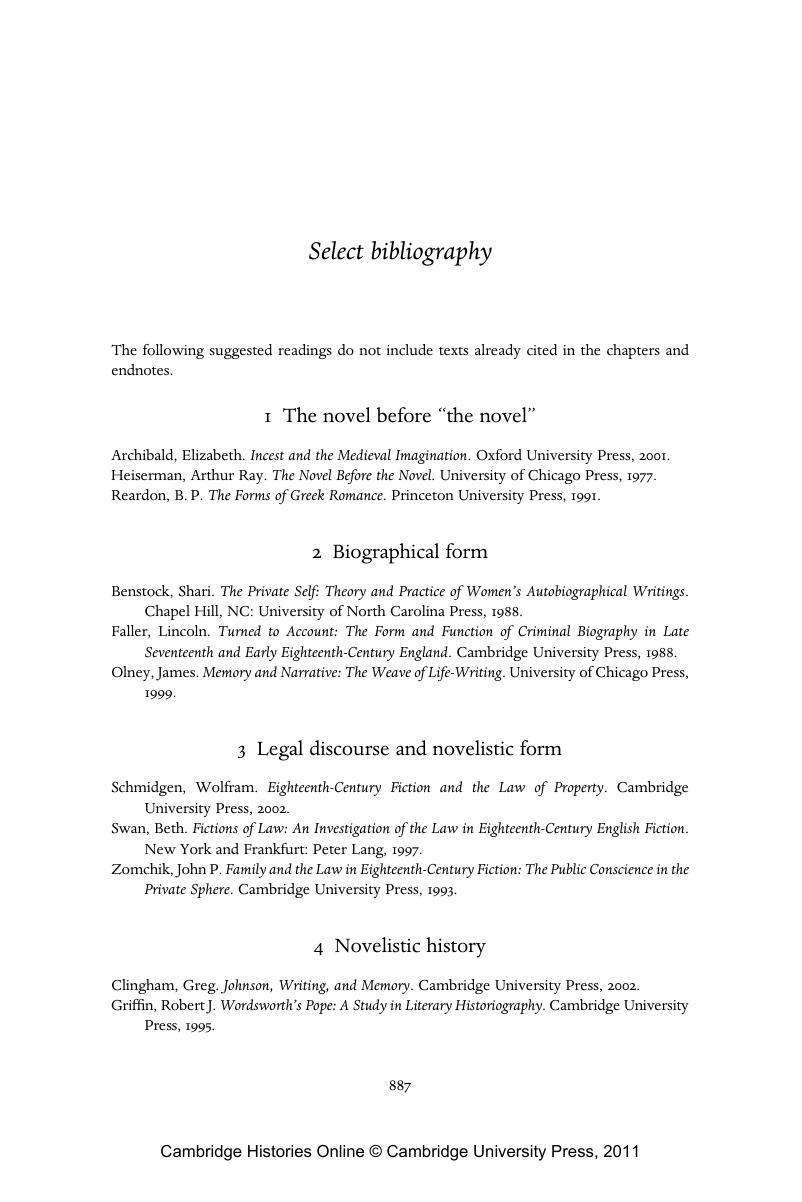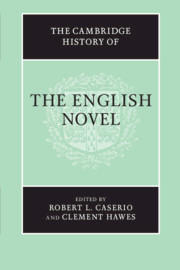Book contents
- Frontmatter
- Introduction
- 1 The novel before “the novel”
- 2 Biographical form in the novel
- 3 Legal discourse and novelistic form
- 4 Novelistic history
- 5 Interiorities
- 6 Samuel Richardson
- 7 Domesticities and novel narratives
- 8 Obscenity and the erotics of fiction
- 9 Cognitive alternatives to interiority
- 10 The novel, the British nation, and Britain's four kingdoms
- 11 Money's productivity in narrative fiction
- 12 “The southern unknown countries”: imagining the Pacific in the eighteenth-century novel
- 13 Editorial fictions: paratexts, fragments, and the novel
- 14 Extraordinary narrators: metafiction and it-narratives
- 15 Romance redivivus
- 16 Gothic success and gothic failure: formal innovation in a much-maligned genre
- 17 Sir Walter Scott: historiography contested by fiction
- 18 How and where we live now: Edgeworth, Austen, Dickens, and Trollope
- 19 From Wollstonecraft to Gissing: the revolutionary emergence of women, children, and labor in novelistic narrative
- 20 Spaces and places (I): the four nations
- 21 Dickens, Charlotte Brontë, Gaskell: politics and its limits
- 22 Populations: pictures of prose in Hardy, Austen, Eliot, and Thackeray
- 23 The novel amid new sciences
- 24 George Eliot's past and present: emblematic histories
- 25 The Bildungsroman
- 26 The novel and social cognition: internalist and externalist
- 27 Clamors of eros
- 28 The novel as immoral, anti-social force
- 29 Sensations: gothic, horror, crime fiction, detective fiction
- 30 Realism and romance
- 31 Spaces and places (II): around the globe
- 32 Imperial romance
- 33 The art novel: Impressionists and aesthetes
- 34 The impact of lyric, drama, and verse narrative on novel form
- 35 Henry James and Joseph Conrad: the pursuit of autonomy
- 36 Joyce: the modernist novel's revolution in matter and manner
- 37 Richardson, Woolf, Lawrence: the modernist novel's experiments with narrative (I)
- 38 Wells, Forster, Firbank, Lewis, Huxley, Compton-Burnett, Green: the modernist novel's experiments with narrative (II)
- 39 Beyond autonomy: political dimensions of modernist novels
- 40 Fiction by women: continuities and changes, 1930–1990
- 41 The novel amid other discourses
- 42 The novel and thirty years of war
- 43 Thrillers
- 44 Novelistic complications of spaces and places: the four nations and regionalism
- 45 The series novel: a dominant form
- 46 The novel's West Indian revolution
- 47 Postwar renewals of experiment, 1945–1979
- 48 The novel amid new technology and media
- 49 Novels of same-sex desire
- 50 From Wells to John Berger: the social democratic era of the novel
- 51 The postcolonial novel: history and memory
- 52 History and heritage: the English novel's persistent historiographical turn
- 53 Twentieth-century satire: the poetics and politics of negativity
- 54 Unending romance: science fiction and fantasy in the twentieth century
- Select bibliography
- Index
- References
Select bibliography
Published online by Cambridge University Press: 28 January 2012
- Frontmatter
- Introduction
- 1 The novel before “the novel”
- 2 Biographical form in the novel
- 3 Legal discourse and novelistic form
- 4 Novelistic history
- 5 Interiorities
- 6 Samuel Richardson
- 7 Domesticities and novel narratives
- 8 Obscenity and the erotics of fiction
- 9 Cognitive alternatives to interiority
- 10 The novel, the British nation, and Britain's four kingdoms
- 11 Money's productivity in narrative fiction
- 12 “The southern unknown countries”: imagining the Pacific in the eighteenth-century novel
- 13 Editorial fictions: paratexts, fragments, and the novel
- 14 Extraordinary narrators: metafiction and it-narratives
- 15 Romance redivivus
- 16 Gothic success and gothic failure: formal innovation in a much-maligned genre
- 17 Sir Walter Scott: historiography contested by fiction
- 18 How and where we live now: Edgeworth, Austen, Dickens, and Trollope
- 19 From Wollstonecraft to Gissing: the revolutionary emergence of women, children, and labor in novelistic narrative
- 20 Spaces and places (I): the four nations
- 21 Dickens, Charlotte Brontë, Gaskell: politics and its limits
- 22 Populations: pictures of prose in Hardy, Austen, Eliot, and Thackeray
- 23 The novel amid new sciences
- 24 George Eliot's past and present: emblematic histories
- 25 The Bildungsroman
- 26 The novel and social cognition: internalist and externalist
- 27 Clamors of eros
- 28 The novel as immoral, anti-social force
- 29 Sensations: gothic, horror, crime fiction, detective fiction
- 30 Realism and romance
- 31 Spaces and places (II): around the globe
- 32 Imperial romance
- 33 The art novel: Impressionists and aesthetes
- 34 The impact of lyric, drama, and verse narrative on novel form
- 35 Henry James and Joseph Conrad: the pursuit of autonomy
- 36 Joyce: the modernist novel's revolution in matter and manner
- 37 Richardson, Woolf, Lawrence: the modernist novel's experiments with narrative (I)
- 38 Wells, Forster, Firbank, Lewis, Huxley, Compton-Burnett, Green: the modernist novel's experiments with narrative (II)
- 39 Beyond autonomy: political dimensions of modernist novels
- 40 Fiction by women: continuities and changes, 1930–1990
- 41 The novel amid other discourses
- 42 The novel and thirty years of war
- 43 Thrillers
- 44 Novelistic complications of spaces and places: the four nations and regionalism
- 45 The series novel: a dominant form
- 46 The novel's West Indian revolution
- 47 Postwar renewals of experiment, 1945–1979
- 48 The novel amid new technology and media
- 49 Novels of same-sex desire
- 50 From Wells to John Berger: the social democratic era of the novel
- 51 The postcolonial novel: history and memory
- 52 History and heritage: the English novel's persistent historiographical turn
- 53 Twentieth-century satire: the poetics and politics of negativity
- 54 Unending romance: science fiction and fantasy in the twentieth century
- Select bibliography
- Index
- References
Summary

- Type
- Chapter
- Information
- The Cambridge History of the English Novel , pp. 887 - 900Publisher: Cambridge University PressPrint publication year: 2012

